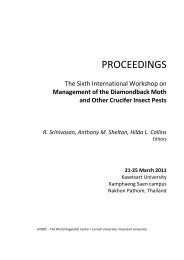Leguminous Vegetable Cultivation and Seed Production S ...
Leguminous Vegetable Cultivation and Seed Production S ...
Leguminous Vegetable Cultivation and Seed Production S ...
Create successful ePaper yourself
Turn your PDF publications into a flip-book with our unique Google optimized e-Paper software.
ean, snake bean, <strong>and</strong> yard-long bean. Cowpea belongs the family Leguminoseae, subfamily<br />
Fabaceae.<br />
Soil <strong>and</strong> Climate<br />
Cowpeuoan be grown in almost all types of soils. It is a warm-season<br />
crop <strong>and</strong> thrives best between 21 <strong>and</strong> 350C. It can be grown successfully in spring summer <strong>and</strong><br />
rainy season in the North Indian plains. It cannot withst<strong>and</strong> heavy rainfall <strong>and</strong> water-logging.<br />
D ifferent cultivars respond differently to temperature <strong>and</strong> daylength <strong>and</strong> thus these are distinct<br />
cultivars for spring summer <strong>and</strong> rainy season.<br />
<strong>Seed</strong> <strong>Production</strong> Techniques<br />
Season <strong>and</strong> Sowing Cowpea can be grown in spring summer <strong>and</strong> rainy season. In<br />
locations where the climate is mild, it can be grown almost throughout the year, but otherwise<br />
photo-insensitive cultivars are grown. In India it is usually sown in February/March in the<br />
Northern plains <strong>and</strong> in December/January in the South for spring summer crop; for rainy season<br />
crop, sowing is done in June/July all over the Indian plains.<br />
Sowing is done in well prepared fields by broadcasting seeds or in line sowing. Usually<br />
15-20 kg of seed is required for sowing on 1 hectare depending on cultivar <strong>and</strong> season. Sowing in<br />
lines facilitate better interculture operations <strong>and</strong> after care. Line sowing can be done by a drill<br />
operated by a tractor, bullocks or manual labor. Spacing between rows should be 45-60 cm <strong>and</strong><br />
between plants 10-15 cm. In case of seed crop, l<strong>and</strong> in which one cultivar of cowpea was grown<br />
the previous year should not be used for growing another cultivars the following year to avoid<br />
contaminations.<br />
Interculture Being a leguminous crop cowpea does not require heavy fertilization. Inoculate<br />
seed with Rhizobium culture before sowing. Application of 10-20 kg N, 50-70 kg phosphorous,<br />
<strong>and</strong> 50-70 kg potash has been recommended by Chauhan (1972 ) .<br />
Cowpea is a shallow-rooted crop <strong>and</strong> requires less moisture <strong>and</strong> light irrigation for proper<br />
growth, as it is sensitive to waterlogging. Irrigation prior to flowering helps in pod setting; another<br />
irrigation should be given after the pods have set. At least one hoeing/weeding after 4 weeks helps<br />
control weeds <strong>and</strong> in root nodulation. Spraying Maleic hydrazide ( MH) at 50-200 ppm just before<br />
flowering was reported to increase the yield of pod ( Choudhury <strong>and</strong> Ramphal 1960 ) .<br />
Maintain an isolation distance of 50 nuDor foundation seed <strong>and</strong> 25 nu for the production of<br />
certified seed between two cultivars ( Anon. 1971). Ripe <strong>and</strong> dry pods are harvested by h<strong>and</strong><br />
picking or by cutting the plants in case of last flush. To avoid shattering of the seeds, harvest when<br />
half to two-thirds of the pod has matured. Some cultivars shatter more than others. This problem is<br />
not encountered in ouldvacuwith flashy inflated pods. Threshing is done by beating widha stick or<br />
by a thresher. Extreme care should be taken during threshing to prevent injury l to1heueod.Tbe<br />
seeds maintain viability for two years under normal storage conditions.<br />
Labial) Beans<br />
Lablab beans are self-pollinated <strong>and</strong> partially cross-pollinated by insects. Different cultivars<br />
should be grown 50 roapart in case of foundation seed ud25roapart in case of certified seed.<br />
Lablab beans are indeterminate in response ionho1operiod <strong>and</strong> there are some short-day <strong>and</strong> longd<br />
types. Lablab bean is a relatively cool season crop adapted to tropical <strong>and</strong> subtropical regions.<br />
Drought-resistant strains are available <strong>and</strong> grown as a dry l<strong>and</strong> crop in regions with minimum<br />
rainfall. Fruiting starts at the onset of winter <strong>and</strong> continues throughout the year. Lablab beans are<br />
grown both for green pods as well as dry seeds. Heterosis may not be of much use in this crop but<br />
cross-combinations showing heterosis vigor can be used to develop high-yielding purelines.<br />
<strong>Seed</strong> <strong>Production</strong> Techniques i~ahlabbeans are annuals of bushy or vining type. When the<br />
vines are supported they may grow as high as 6-10 m. They are usaully grown as oso{e crop with<br />
5
















